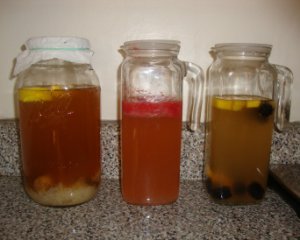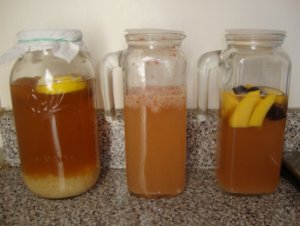
 To Buy Master Cleanse Set & Supplies, Visit
To Buy Master Cleanse Set & Supplies, Visit
I am very excited to tell you about a beverage that I have been making for our family for a couple of months now. It’s called water kefir. The best way to describe it is flavored soda minus all the processed sugar, artificial colors, flavors and preservatives. Water kefir is nature’s way of making soda and by far, one of the healthiest and easiest to make at home. And because I love it so much, I spent the time to write a detailed manual, as well as record two instructional videos, on how you can make your own water kefir at home.
What is Water Kefir?
Water kefir is made from kefir grains, also known as sugar grains, tibicos, tibi, or Japanese water crystals. The grains make up a cultures of various strains of healthy bacteria and yeast, held together in a polysaccharide matrix created by the bacteria. The symbiotic relationship of the microbes produces a stable growing culture. The microbes feed on sugar and produce lactic acid, alcohol (ethanol), and carbon dioxide, yielding a fermented carbonated beverage. The alcohol content is usually very minimal, less than 1 %.
Water Kefir vs. Milk Kefir
There are two types of kefir grains – milk and water kefir grains. Prior to making water kefir, I was making milk kefir using raw cow’s milk. Though similar in function, milk grains are quite different than water grains. They are white, cottage cheese-looking with slimy feel to them. Water grains, however, are translucent, cauliflower-like and easily break apart under pressure. Also, milk grains feed on the lactose in milk whereas water grains feed on sugar.
Health Benefits of Water Kefir
The health benefits of consuming water kefir are endless. They are a natural supplier of probiotics to our digestive tract. Probiotics refers to the healthy bacteria that usually feeds on the “bad” unhealthy bacteria in our stomach and intestines. Bacterial overgrowth can lead to many illnesses some of which include fungi, yeast infections, indigestion, obesity, Irritable Bowel Syndrome, Crohn’s Disease, skin disorders, etc. By drinking water kefir you will bring balance to your internal microflora. Many people take a probiotic supplement daily for this particular reason but I prefer to drink the water kefir. It’s much tastier and more affordable in the long run.
 Dr. Gabriel Cousens, a leading expert in the raw food community, writes in his book “Rainbow Green Live Food Cuisine“:
Dr. Gabriel Cousens, a leading expert in the raw food community, writes in his book “Rainbow Green Live Food Cuisine“:
“Kefir grains produce right-rotating L(+) lactic acid, which is an important constituent of the human body. It is particularly important in the prevention of cancer and has been used experimentally with success in the treatment of cancer. In addition, right-rotating lactic acid may help maintaining healthy functioning of the heart. According to some researchers, the cells of the heart muscle obtain their energy primarily from right-rotating lactic acid.”
Another health advantage of water kefir is that people who do not wish to consume dairy or have a vegan type diet may find that water kefir provides the living probiotics without the need for dairy or tea cultured products, like kombucha.Vegans also may like to know that through the fermentation process kefir becomes an excellent source of vitamin B12, and is high in vitamins B1 and B6.
Diabetics, in particular, could greatly benefit from drinking kefir. Since the finished product, if bottled, will produce a carbonated beverage, it provides an alternative to sweet soda drinks. In that sense, anyone from children to adults can enjoy water kefir guilt-free.
How to Make Water Kefir
Making water kefir is super easy and fun. To help illustrate the process I have created two video tutorials – one on how to make the basic water kefir recipe, and the other on how to make flavored water kefir. You can watch them below.

Tools Required:
- Plastic strainer
- Plastic measuring spoons
- Plastic spoon
- Measuring cup
- 8-cup (1/2 gallon) Ball Mason jar
- 2-3 Glass pitchers or Ball Mason jars
Ingredients needed:
- Filtered or spring water
- Water kefir grains
- Organic cane sugar
- Sucanat, raw sugar or coconut palm sugar
- Unsweetened, unsulfured dried fruit (apricots, figs or raisins)
- Organic lemon (optional)
Notes 1: it’s very important that you NEVER use any metal utensils or tools when handling living cultures such as kefir grains. They don’t like metal and may be adversely affected if exposed to it.
Notes 2: never use tap water because it contains chemicals such as chlorine and fluoride. They will kill the grains. Make sure the dried fruit doesn’t have any sulfur dioxide added to it. Many conventional brands add this chemical to keep the dried fruit looking bright and fresh.
Basic water kefir formula:
- 1 Cup of water
- 1 Tbsp. of sugar
- 1 Tbsp. of kefir grains
- Few pieces of dried fruit
Notes: The ratio of 1-1-1 is what you need to follow.
My video tutorial recipe:
- 6 Cups of water
- 6 Tbsp. kefir grains
- 4 Tbsp. organic cane sugar
- 2 Tbsp. coconut palm sugar
- 4 pieces of dried apricots and figs
- 2 lemon wedges
Notes: When dividing the sugar always add more organic cane sugar and less sucanat, raw or coconut palm sugar. Kefir grains thrive primarily on the organic cane sugar. The other sugar and dried fruit are added to give them additional nutritional support their growth.
The fermentation process
After all the ingredients are in the jar, you need to cover the top of the jar with a cloth, paper towel or parchment paper held by elastic. This is so your kefir grains can breathe and to make sure nothing can contaminate them. Putting a tight lid could cause the jar to explode due to the natural carbonation process taking place.
Place the water kefir jar on your counter away from direct sunlight. The kefir water should be ready in 24-48 hours. The kefir will be mild and sweet at 24 hours, and more zesty and acidic at 48 hours. This is really a matter of personal preference and either way is tasty and has health benefits. Temperature can speed this process up the warmer it is inside your house. If it tastes like there is too much alcohol for you try reducing the amount of sugar and fruit or reduce the amount of grains. You will soon find what you like after a couple taste tests.
How to Make Flavored Water Kefir
YOU MIGHT ALSO LIKE












